
Garbage gobblers: a tale of tiny garbagemen
If you have ever thrown a party to which you invited a lot of people, you are probably
familiar with the path of destruction and garbage your guests leave behind. Now imagine
the pile of garbage that a city generates, in which the party goes on all year round. The
city of Amsterdam, for instance, produces more than 300,000 tonnes of municipal waste
per year(1,2). No one would like to be the host of that party. Luckily, we are not alone in
cleaning up the mess that our cities produce. We get help from other organisms,
microbial aides that break down our plastics, our garden refuse and the sewage we
produce. For them, the party is just getting started when the waste is served, and they
can boogie all night long to the garbage groove. We will be discussing three of these
fabled parties. First on the list: a smoking hot gathering in the compost heap, where all
the microbes gather to have a smouldering good time. Our second destination: a plastic
fantastic party where microbes break down the house, and finally, the afterparty of the
century: a dance in the deep dank drains where sewage reigns. From the hot steaming
mess that is the compost heap to the sewage sludge, we intend to show you how
microscopic garbagemen help manage the mess that humankind leaves, help by
excreting, chewing, pushing and shoving their way through a veritable heap of refuse.
So, what are we waiting for? Let us go and see how microbes help us in these three
waste streams, let us go dumpster diving!
Heaps of fun
Where to begin this journey into the ebb and flow of microscopic garbage management? In the
compost heap, of course! The composting process is the most obvious example of waste
biology. Microorganisms facilitate the efficient disposal of organic waste. In addition, organic
matter is recycled into a useful fertiliser, since compost contains all the nutrients a plant needs.
After the plant has grown, it, in turn, will close the circle of composting by ending up on a
compost heap(3).
What is composting?
Compost piles usually consist of organic, or green, waste like garden refuse and vegetal waste.
Microorganisms like fungi and bacteria, and also small animals like earthworms, help to break
down the organic substances(4-7). The various molecules that constitute the organic waste all
possess different chemical properties. The main component of green waste is mostly volatile
matter, like terpenes produced by the fungi inside the heap(8). Large molecules like cellulose (the
primary constituent of a plant cell wall), lignin (what most people would call 'wood'), and starch
are abundant as well. Certain elements like nitrogen, phosphorus, and potassium are also
present in the heap. And last but not least, crude fibre and of course lipids, sugars and proteins
are a part of green waste(6). Converting these components into compost, mostly through
aerobic
processes, is what we call 'composting'.
Stage diving
Composting is not a continuous process, but it takes place in several steps. These steps are
defined by what kind of organisms are active, the state of the compost and which compounds
are degraded(6). Usually, four different steps can be distinguished: the first mesophilic phase
(stage 1), the thermophilic phase (stage 2), the second mesophilic phase (stage 3) and a
stabilising phase (stage 4) (figure 1). Stage 1 and 3 are characterised by temperatures of
around 10 to 42 degrees Celcius, which are temperatures at which mesophilic organisms are able to survive.
Temperatures around 45 to 70 degrees Celcius, define stage 2. These high temperatures are due to the high
metabolic activity of the microorganisms and provide the perfect circumstances for
thermophilic microbes. Thermophilic means that these microbes are able to survive these high
temperatures. The exact time it takes to go through a certain stage is variable, as it depends on
the density and makeup of the organic waste. It is easy to imagine that it takes longer to
compost wooden branches than old bread(9). Let us now dive into these stages in more detail.
Which microbial garbagemen are active during each one, and what is broken down?
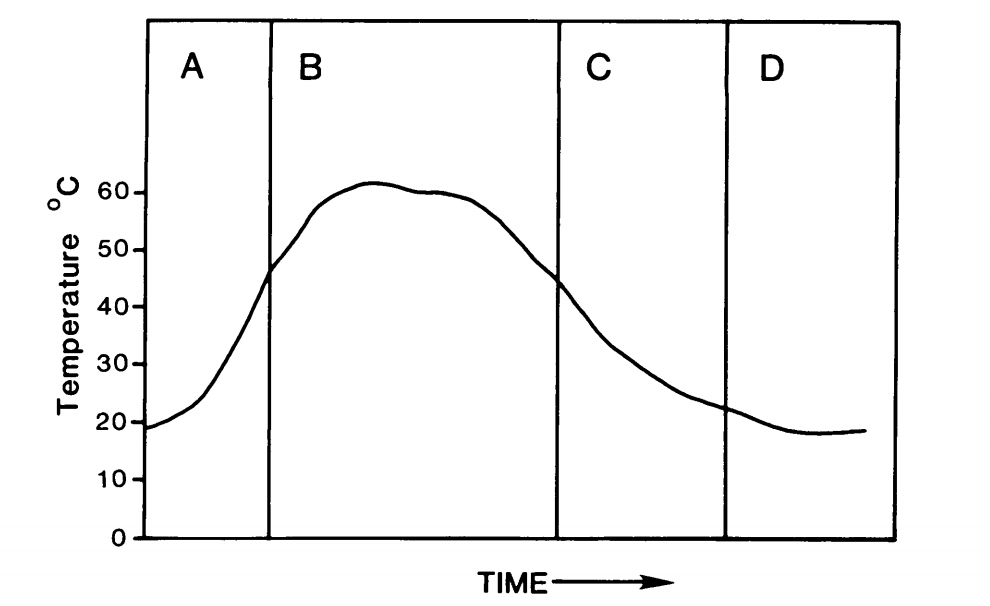
Figure 1:The stages of composting. A: first mesophilic phase (stage 1), B: thermophilic phase (stage 2),
C: second mesophilic phase (stage 3), D: stabilising phase (stage 4). Source: Fogarty, A. M., & Tuovinen,
O. H. (1991). Microbiological degradation of pesticides in yard waste composting. Microbiological reviews,
55(2), 225-233.
Tiny gargbagemen on the job
There are numerous, diverse and tiny garbagemen that facilitate the composting process. They
comprise several groups of bacteria and fungi. Each and every one of them fulfills its own little
task in converting the pile of organic waste into compost. Different components of the waste are
degraded in the different stages of composting, so a succession of dominant species takes
place.
Stage 1
Stage 1 only lasts a couple of days at most. During this phase, small molecules like monomeric
sugars and organic acids are quickly taken up by most heterotrophic organisms(6), since these
molecules are easiest to digest and readily available. One would expect bacteria to thrive on
this easy food source. However, something else is at play here. In this stage, the pH is often
low, between 4.5 and 6. While fungi are intolerant to high temperatures, they are more tolerant
than most bacteria to low pH. Therefore, one hypothesis is that fungi break down acids and
some other easily digested nutrients in this stage, which raises the pH. The waste then
becomes more accessible to thermophilic bacteria, and the next stage starts. Fungi thus
dominate this stage. However, the data does not always agree on this, and some bacteria are
already present in this stage(10,11). To summarize, there is a transition from acidic conditions and
fungal dominance to less acidic conditions and gradually more bacterial breakdown.
Stage 2
At some point, breakdown increases so much that stage 2, the thermophilic stage, is reached.
This is the stage that most people have seen, the stage of the steaming compost pile (figure 2).
It can last for weeks or even months. There is no change in the type of components that are
broken down. The organisms still feed on the 'easy' food sources such as starch. The
exponential increase in bacterial breakdown makes temperatures rise to 40 to 70 degrees Celcius. This is
simply a byproduct, and can have negative effects. The optimum temperature for composting
lies between 30 and 55 degrees Celcius, while a temperature of 70 degreed Celius inhibits the growth and the metabolic activity of almost
all microbes(6,12). It is a strange detail, then, that the frenzy of breakdown actually means suicide
for some of our garbagemen. They prefer mesophilic temperatures (20 - 45 degrees Celcius) and cannot
survive the heat they produce. For example, mesophilic bacteria that are able to break down
starch undergo a 100-fold decrease in their population size. They are replaced by their
thermophilic brethren. Even heat-resistant bacteria can have some trouble with the extreme
temperatures in this phase. Most of them, however, are able to produce spores: heat-resistant
survival capsules, which enable them to survive the high temperatures(6). Nevertheless, the
experts in heated garbage disposal also decrease in numbers during this phase, which is
indicative of the extreme conditions in the heap(11). Thus, while bacteria dominate this stage, only
a select few prosper(10,11,13). At some point, activity dies down again. The easily digested
compounds have been broken down, and metabolic activity returns to lower levels. Stage 3 can
then begin.
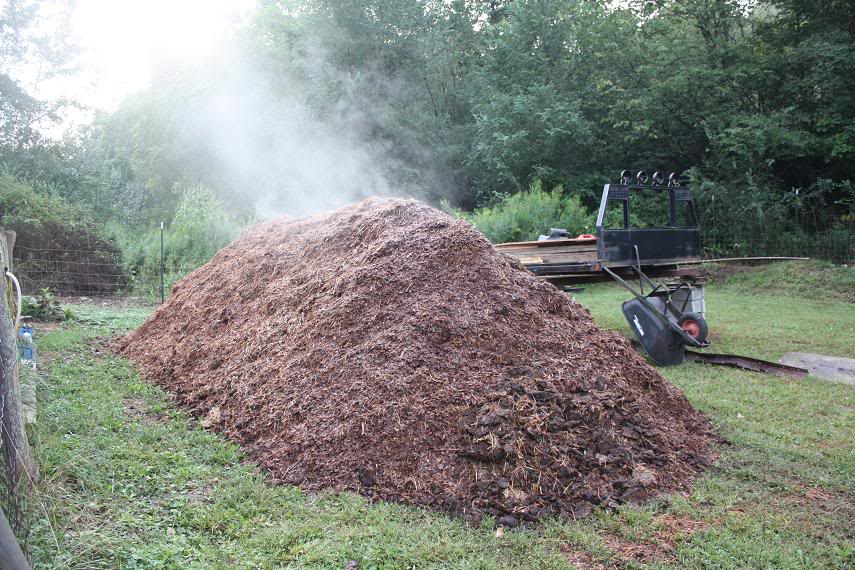
Figure 2: High metabolic activity inside the heap causes the compost to steam. Source.
Stage 3
As the temperature decreases to between 10 and 42 degrees Celcius, overall microbial diversity increases
again(6,9,11,14). Cellulolytic microbes start to thrive now, which is no coincidence. Larger molecules
such as cellulose, hemicellulose and lignin take longer to break down and are only now
becoming attractive energy sources, as the smaller molecules are being depleted. For a size
comparison, starch consists of monomers of glucose. These individual components are easily
taken from the starch polymer and digested. Lignin, however, is a hugely complex molecule that
is very hard to break down. It is for this reason that breakdown of difficult components such as
lignin is only now becoming attractive (figure 3). Fungal garbagemen, in particular, are true
experts in breaking down large, resilient molecules(6,11,13). This stage does not have a specific
duration, as it depends on how many woody components the compost containss(6).
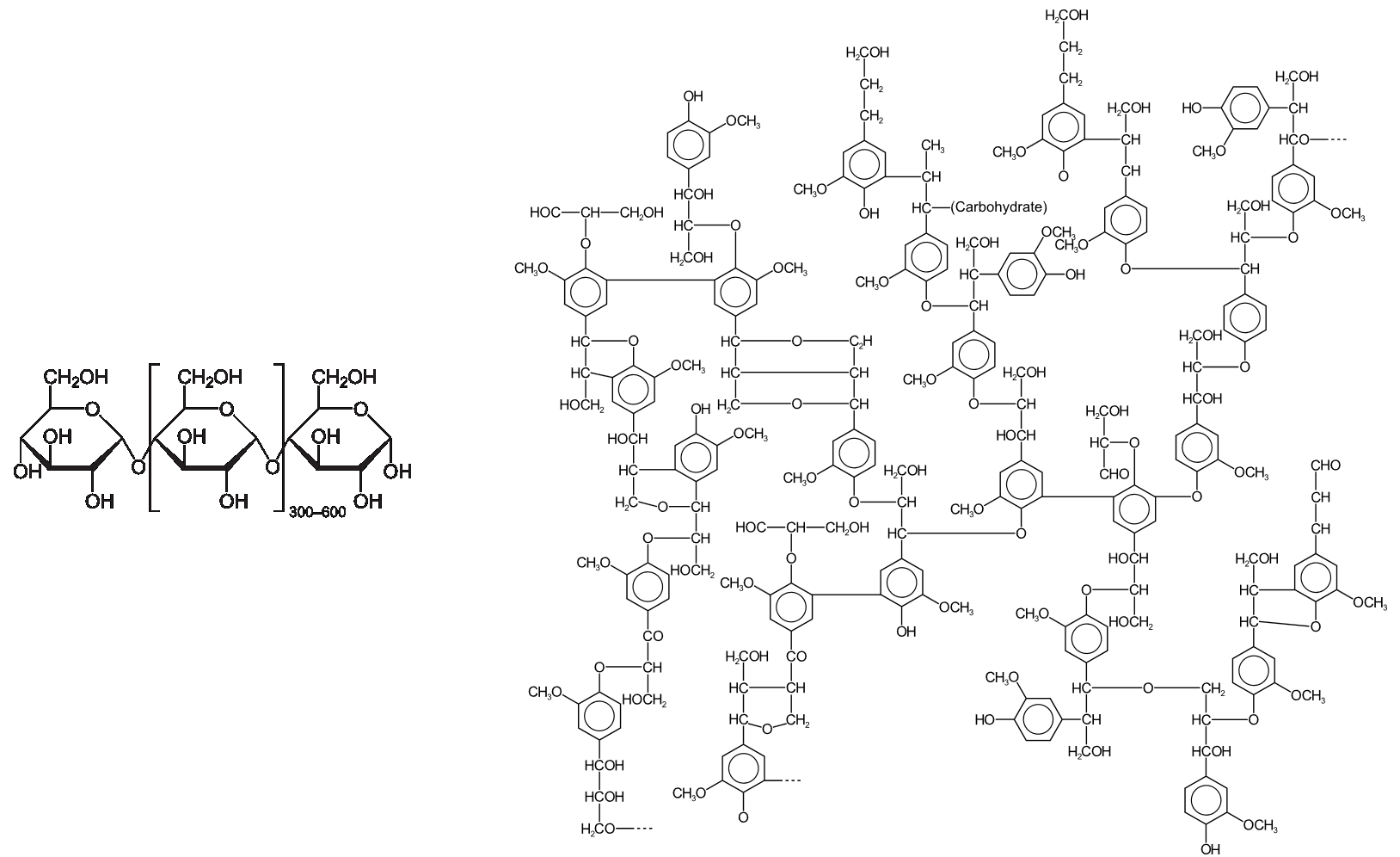
Figure 3: A comparison between starch (left) and lignin (right) to show the difference in complexity.
Starch is a polymer of glucose, of which a monomer is shown between square brackets. Lignin is a huge
interconnected molecule that can only be broken down by fungi. Source 1. Source 2.
Stage 4
Bacteria have lost most of their activity during stage 4. However, the largest fungal diversity can
be detected at this point(11,13). By this time, many different fungal species are diligently degrading
the remaining bits and pieces of the compost. Their scavenger hunt can last for several
months(9,11,13).
Composting conditions
During all the stages, several conditions must be met for efficient composting. As you have
seen, temperature plays an important role, but it is a by-product. pH is also very important. Two
characteristics that we have left undiscussed are oxygen availability and the need for water in
the heap.
Go with the oxygen flow
The aerobic organisms in the heap need enough oxygen to keep their metabolism, and thereby
the decomposition of the matter, going(6). Oxygen levels of a compost heap should not drop
below 18%, as this will stagnate decomposition and cause the anaerobic formation of
greenhouse gases(6,15,16). The aeration of a compost heap is therefore very important, since these
gases must be allowed to escape. Good aeration can be achieved by adding materials that let
through air, like sawdust and branches. When layers of sawdust and branches are interspersed
with layers of denser materials such as grass and leaves, the air can flow through and aerobic
metabolism can continue unhindered. Turning the matter in the pile upside down can be
beneficial, if not done too often. Too much disruption can destroy the hyphae of composting
filamentous fungi(6,15).
Watering the waste
Keeping the compost moist is crucial to efficient composting, as most decomposers live in
biofilms(9). Biofilms are microbial communities that form on thin layers of liquid. By keeping the
moisture content constant, biofilms can be formed. This promotes bacterial growth and
decomposition of the organic matter. The optimum moisture content lies between 30% and 65%
(9). More liquid will inhibit oxygen diffusion through the compost, which is not favourable for
aerobic bacteria. In addition, nutrients will be lost by leaching(17). On the other hand, a moisture
content lower than 30% impedes the biofilm formation and most organisms will become
inactive(9).
Plastic fantastic
Unlike green waste, plastics are not readily degraded by microorganisms. Plastic is a manmade
product. Since plastics only came into existence in 1907 and represent a wholly new class of
carbon source, few organisms can break it down. For the most part, they simply have not been
around long enough for organisms that can break them down to evolve. Exceptions do exist, as
you will see. There are many types of plastics and describing each and every one of them would
be plain boring. Therefore, we will only focus on the degradation of the most abundant plastic in
the world: polyethylene, or PE. With a global annual production of 140 million tonnes, it certainly
contributes to environmental pollution(18). Although you might not recognise this name, you will
most certainly know items that are made of it. Garbage bags, cling film and most plastic bottles
are made of PE(19). PE is also used in products for agriculture, such as mulching, greenhouses,
and tunnel film(20). It is a thermoplastic, which means it can be heated and cooled many times
without showing signs of wear and tear(21). As the word polyethylene implies, PE is a polymer of
ethylene, with the following molecular formula: (C2H2)n. The molecular weight of these polymers
can vary between 4000 Da and 28.000 Da. Though plastic is hard to stomach for the tiny
garbagemen, some bacteria and fungi are known to degrade PE. With some help they are able
to break down the polymer and use it as a carbon source. First, the material has to be
pretreated, after which the microbes can dig in.
Getting rid of PE
Considering glucose, the most widely used carbon source, has a molecular weight of only 180
Da, PE might be a little bit too big for these small organisms to sink their teeth into. Since
microbes do not possess teeth, they might need a little help chopping it up. Molecules with a
molecular weight of 500 Da or smaller lie more within their range of degradation(19). Usually, this
chopping up is performed by pretreating the PE by either photo-degradation or thermo-
degradation. This means that the plastic has to be irradiated with UV-light or heated. Under
these conditions the material oxidises, a process that can be sped up by either incorporating
pro-oxidants in the PE during production or adding them later on in the degradation process.
Pro-oxidants are usually transition metals, such as copper, iron and manganese, which are very
reactive because of the free electrons in their atoms. During pretreatment the PE becomes
brittle, porous, more hydrophilic and partly oxidised; perfect conditions for microbes to colonise
its surface(20).
Plastic colonisation
Plastics start falling apart as they become more brittle and porous during pretreatment. This
process provides more surface area for the microorganisms to live on and thus a quicker
degradation of the plastic. The fact that the surface becomes more hydrophilic by pretreatment
plays a key role in microbial colonisation(22,23). Although PE's hydrophobicity can inhibit microbial
colonisation, some organisms have found their way around it. Certain bacteria, when deprived
of carbon, get a more hydrophobic cell wall, which allows them to attach to hydrophobic
surfaces. However, their metabolic rate will not reach an optimum under these conditions, for
certain metabolites have a better diffusion rate under hydrophilic conditions. Therefore, it is still
more rewarding to pretreat (oxidise) the PE surface to make sure biodegradation can occur
under optimal conditions(24). The outer layers of pretreated plastics are chock-full of tasty oxidised
functional groups, which most decomposers are able to take up into their cells. They gorge
themselves on these groups, using the released energy to survive and reproduce(23).
But how?
How the bacteria and fungi are capable of breaking down the strands of PE is uncertain. The
exact enzymes involved have still not all been identified. Peroxidases, for example, are known
to degrade lignin, a natural polymer in wood. Their presence seems to have a positive effect on
the degradation of PE(23). Another enzyme suspected to be involved in this process is laccase.
Several different organisms that produce laccase have been isolated in PE degradation
assays(25). By looking at how PE's properties change during biodegradation, this process can be
better understood. Via spectrometry, the presence of functional groups on the PE surface can
be determined. For example, the presence of double bonds and carbonyls can be examined,
for these might indicate that biodegradation takes place. Some organisms are known to induce
a decline in carbonyl groups, while double bonds increase during PE degradation. Surprisingly,
other groups of organisms seem to have the opposite effect on these functional groups during
PE degradation. This just goes to show the complexity of the degradation process that the tiny
garbagemen are attempting. It seems that each and every one of them has its own eating habits
and dietary preferences. Indeed, most research groups used different kinds and combinations of
microbes(23). We can state that the tiny garbagemen have found intriguing and mysterious ways
to cope with the new challenges that we pose as mankind.
Activated Sludge: much better than it sounds
Microorganisms are also of importance in the breakdown of some rather more personal and
organic waste. It's brown, it's yellow, and we deposit it en masse in porcelain receptacles, to be
flushed away into oblivion. That's right: the nutrients in our faeces and urine, leftover waste of
our metabolism and nutrient extraction, are a right banquet for the microbes in sewage
treatment plants (figure 4). Collectively, these microbes are known as active sludge, which
tastefully illustrates the high regard in which our microbial helpers are held. An important
component of the waste they digest is in nitrogen compounds. We will focus on the nitrification
process, wherein the nitrogen content in our wastes is converted to nitrate, as an illustration of
the power of bacterial cleansing. Excess nitrogen content in the wastewater after treatment
would lead to eutrophication, an increase in nutrients that can upset river and coastal
ecosystems, and toxicity to fish(26). Bacteria help in this undertaking. So, to quote a famous tv
programme: 'How do they do it?'.

Figure 4: The active sludge in action. The water with sewage contains numerous bacteria that are
munching away on the waste. Source.
Processing...please wait
Sewage is collected and transported to sewage treatment plants. During this transportation, the
organic nitrogen contained in urea and faeces is converted into ammonia by anaerobic bacteria
(26). Once the matter has arrived at the plant, it is treated in three main stages. First, the sewage is
led through a filter, which removes large refuse objects such as tin cans, branches, or bottles.
Then, it is led through a series of tanks called primary clarifiers. In these tanks, the large
particulate matter of the sewage sinks to the bottom, to be collected and removed. This is
primarily sand and grit in the water that settle at the bottomh(27,28). The settled waste is removed
and the water flows on to the next step in the process: the secondary treatment. This is the
biological component where breakdown of all manner of organic substances occurs. Oxygen is
supplied in aeration tanks, and consortia of bacteria use it to break down these substances.
During this process, the bacteria multiply and form suspended blobs, called flocs. Figure 5
shows one under the microscope.
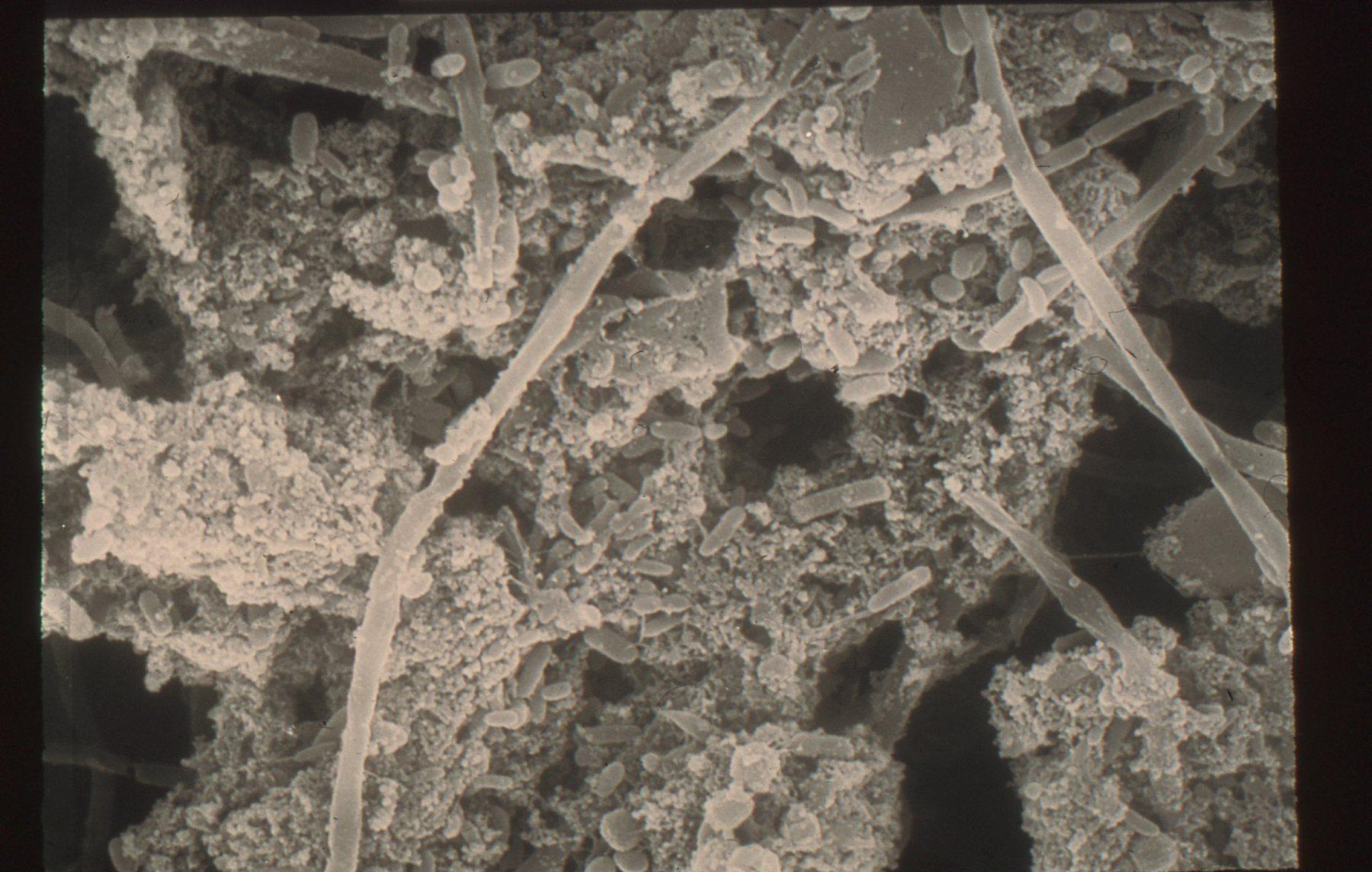
Figure 5: A floc of bacteria from activated sludge. Note the long filament-like bacteria, and the rod-like
bacilli. Source.
In these blobs, many bacteria clump together with their substrate and an extracellular matrix(29).
To remove the flocs, the water is led to the next step in the process: sedimentation in a
secondary clarifier. Here, the bacterial sludge that has grown, along with undigested matter,
settles on the bottom. The bacteria have grown on all the organic compounds in the water, and
with their removal, the water is clean. Part of this sludge is recycled back to the beginning of the
process, the rest is removed for further processing. The latter can encompass anaerobic
digestion, where anaerobes eat the bacteria and leftover nutrients present, or composting,
where the sludge is combined with agricultural waste and composted(27). Both methods are meant
to reduce the volume of the leftover sludge, but in anaerobic digestion, biogas is produced. This
can be tapped and used for power generation or heating. In the end, the sludge is burnt (and
the ashes disposed of), or directly removed to garbage disposal sites. See figure 6 for an
overview of the process. For now, let us focus on the nitrification process that takes place during
the secondary treatment.
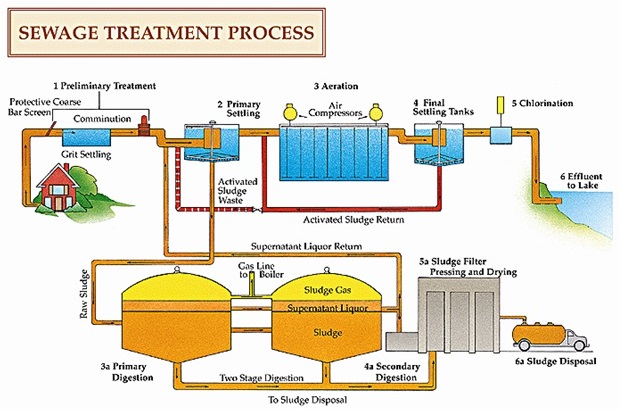
Figure 6: A diagram showing an overview of the sewage treatment process. We will focus mainly on the
breakdown of nitrogen-containing substances (mostly NH3) in the aeration step (step 3 in this figure). Note
that the effluent could also be pumped to rivers or the sea. Source.
Nitrifighters
Recall that the nitrogen content of sewage is mostly contained in ammonia (NH3) by the time it
arrives at the treatment facility. Its removal happens in three separate stages. There is the
change from ammonia to nitrite (NH3-, NO2-), the nitrite oxidation stage (NO2-, NO3-), and then
an anoxic process whereby NO3- is turned into nitrogen gas and oxygen(26,30). The first two steps
are aerobic and are performed by different microbial communities: the ammonia-oxidising
bacteria (AOB) and the nitrite-oxidising bacteria (NOB). These groups of nitrifiers are both slow
growers, but NOB in turn grow more slowly than AOB. Since the NOB depend upon the
products of the AOB, a delicate balance exists. The two groups respond differently to
environmental conditions, so it is difficult to keep this balance. For example, high NH3
concentrations can result in significant reduction of nitrite oxidation, leading to toxic build-up of
nitrite and failure of the process(26). Let us see what process conditions influence this delicate
balance. How is optimum nitrification by these microbial helpers guaranteed?
Process parameters
What parameters influence the nitrification process? pH and temperature are important
environmental factors. Efficient nitrification happens at a pH between 7.5 and 8.5(26,31,32). It is not
fully understood why. The optimal temperature range for nitrifiers lies between 25-30 degrees Celcius, where
every higher temperature is better(26,32). A very important factor in the process is the resilience of
the nitrifying community to different inflow parameters. The concentration of ammonia in the
wastewater that reaches the plant fluctuates. Recall that the balance between AOB and NOB is
important and fickle. One measure to better maintain this balance lies in increasing the species
richness of both AOB and NOB. If more different species of bacteria are present, the system as
a whole will be more resilient to differences in inflow wastewater and environmental conditions.
This is because there is a greater chance that bacteria are present that can efficiently handle
the new conditions. Think of the active sludge. Microbes eat the ammonia and nitrate, but are
then removed in the secondary clarifiers. Some are recycled back to the start of the process,
where there is a lot of food. The process is very quick, a matter of hours, and in the secondary
clarifiers, food is all but depleted. This climate favours fast growers only, microbes that can
make use of lots of food quickly, and then stand starvation. A solution lies in membrane
bioreactors: the water with sludge is led through membranes that allow water to pass, but retain
the sludge. The result is a more constant supply of nutrients and less selection on fast growth in
high nutrient conditions. This gives slow-growing species a chance, thereby diversifying the
species pool(26) By doing this, the amazing nitrifighters prevent eutrophication of lakes and rivers.
Clean-up complete
Urban biology can be found everywhere in the city: even in our garbage and sewers. While the
garbage we generate is simply useless trash to us, many tiny garbagemen go wild in our waste.
Like those that manage to degrade our organic waste through composting, a job that requires
teamwork and brings on the heat for our tiny garbagemen. Plastic degradation might be an even
bigger accomplishment than composting, as the material has only been around for such a short
time. True, they still need aid in this breakdown through pretreatment, but our miniscule heroes
are already making an effort. It is only a matter of time. The tiny garbage disposal professionals
will not even flinch in the face of faeces, as they regulate the delicate process of nitrifying our
excrements, protecting lakes and rivers alike from eutrophication. We can conclude that our tiny
garbagemen are true garbage heroes, so the next time you get rid of your waste (internal or
external; it is up to you), you should say 'Thank you, tiny garbagemen!'.













